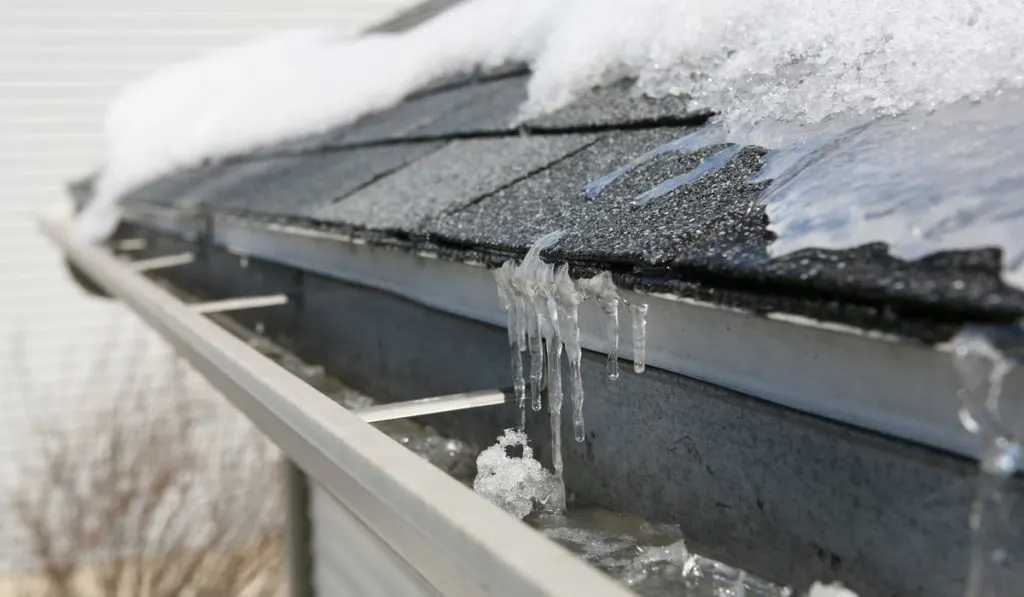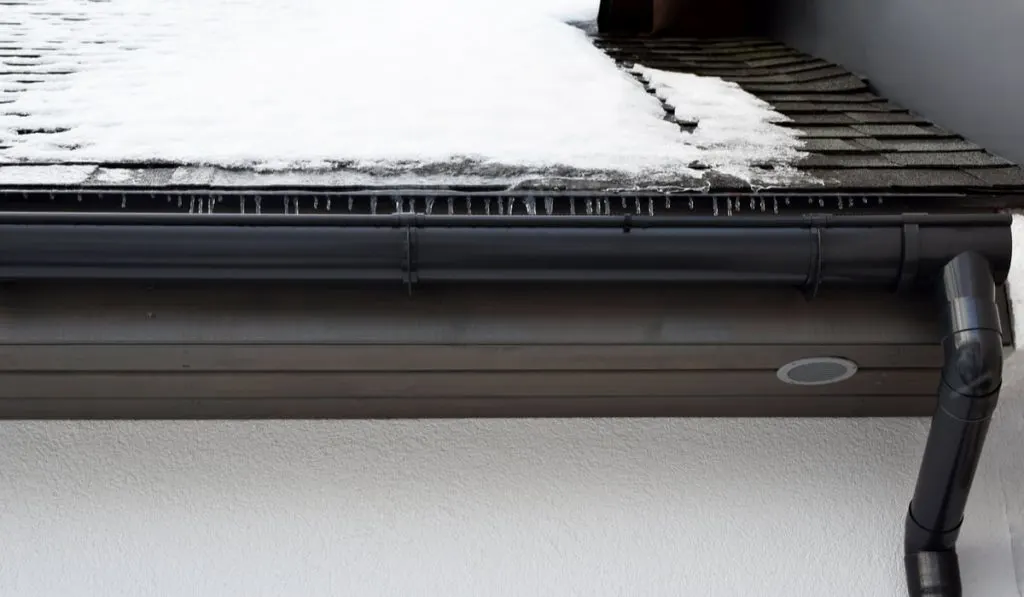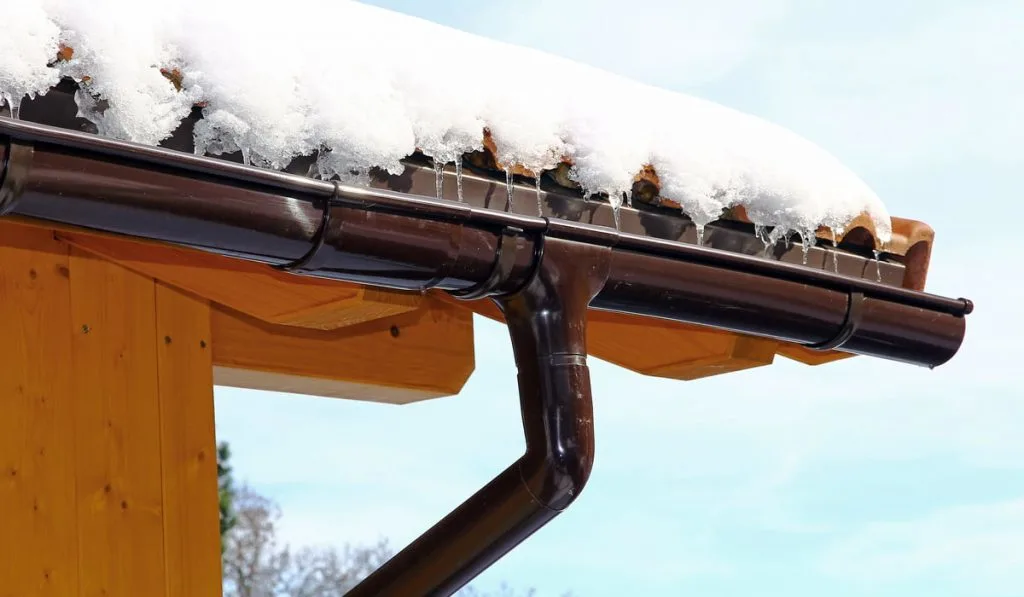Another home project, huh? But this time in the winter! Usually, you wait until spring to start doing home projects, but I guess this time your spouse kicked you out early. I mean, gutters are a necessary part of protecting your home, so if you need to install them, it’s better to do so sooner rather than later!
Gutters collect, hold, and channel the water runoff from your roof. Rather than letting it flow down the walls and hit you on the head when you walk out the door, or seep in behind shingles or siding and cause moisture problems, the gutters direct all the water off your roof safely down and away from the house.
This also avoids pooling and water issues on the sides of your house. If water just came straight down, it would all land right at the base of your home, and cause rot and degradation of your walls and foundation.
Both of these problems are much more expensive to fix, and much longer in construction time than the cost and time taken to install gutters.
Better to do the gutter install, then! Perhaps your home no longer has gutters, due to damage from the past or because it’s a new house and they haven’t been installed.
Or, maybe you need to replace your gutters and get new ones. Whatever the reason for new gutters, it’s smart to do it in the winter when possible. Winter is full of rain, sleet, and snow falling onto your house, melting, and running down your roof.
If you wait until spring to install, you may be spending your spring home renovation budget on fixing your home’s foundation rather than new countertops in the kitchen!
So, you’ve decided it’s better now than later– or at least, someone did, and you got roped into being the one to install them. It’s cold outside, and you have no experience installing gutters.
What materials do you need? Ladder, screwdriver…. hammer and.. nails? How do you even begin? Where do you begin? Help would be appreciated! Great, because the answers can be found right here in this article! Read on to learn the most essential tips for installing your gutters in the dead of winter!

1. How Do I Know My Gutters Need to Be Replaced?
It’s important to know when it is the right time to replace your gutters because gutters that are not fully functioning can lead to water damage to your roof, the siding of your house, and the building’s structure.
When you have a big rainstorm or snowstorm, or some other big weather event, it’s good to go out and check on your gutters to make sure they haven’t been damaged.
If there are any separated joints in the gutter trough or sagging places along the line, call a gutter professional to come over and inspect your gutters. If they conclude it needs to be replaced, you can move on from there.
You can either have professionals come in and do it, or you can do it yourself. If you’ve anointed yourself a proficient handyman, or have checked the books and it’s more affordable for you to do it yourself, you can replace the gutters yourself.
Keep reading to learn how, and just as important, when.
2. Whether to Install This Winter
Even though spring is the ideal time for home renovation, gutters can still be installed in the winter. However, you need to be careful about your timing in installing your gutters because the wrong weather can cause a pile of problems.
You’ll want to avoid extremely cold temperatures and days with heavy snow and ice.
If there’s ice on the ground or heavy snow on the roof, you’ll want to wait for a drier, warmer winter day to install. Not only because it can be dangerous for you to work in such conditions– don’t ever climb up a ladder that’s standing on ice!– but because lacking gutters with so much water will cause major issues.
If you’re replacing your old gutters when it’s all snowy outside, and it begins to melt before you’ve finished, which is quite possible depending on day-to-day temperature changes, the water will start running off your roof and beginning those water damage issues instead of going into the gutters, no matter what shape they are in currently.
You need to have an established water flow system so the water doesn’t damage your home and your yard’s landscaping. So, if it’s dry, you can go right ahead, but if it’s the middle of snow or rain season, it’s best to wait until it’s all thawed.
3. Winter Weather Warning: Beware of Ice Dams!
Ice dams can fool you into thinking it’s a good time to install your gutters when it is not! Ice dams are when a buildup of ice is created at the edge of your roof.
Typically, this is due to snowfall and the weather warming and melting the snow, but it doesn’t melt it enough before it freezes again, creating a layer of ice.
Over time, the ice will melt and begin running down the roof, freezing, and melting again, pooling it all at the edge of your roof and making the ice dam bigger and bigger.
The roof may look mostly melted, and you’re eager to start. It’s only a little bit of snow on the edges, what harm can that do? Well, installing your gutters with the ice dam there may seem fine at first until it begins to melt.
If you were to install the gutters anyway, the space that you’ve had to install around because of the ice dam will be vulnerable to letting water flow where it shouldn’t. Especially if the dams increase in size.
Before beginning your installation, make sure that any ice dams that may have formed have completely melted.

4. Gathering Materials: What to Buy
All good? Picked a warmer, sunny day and confirmed there are no ice dams or snow on the roof or ground? Sweet. Now it’s time to gather the tools of the trade!
To install your gutters, you’ll need a stable ladder to hold you as you maneuver at great heights. Make sure that the area you’ll be working in is clear of any lawn toys, furniture or decor, and that there’s nothing underneath you that could be damaged if you dropped a tool.
You may want to deploy a couple of people to supervise you and hold the ladder to make sure you stay safe out there.
Next, you’ll need a measuring tape, a pencil, chalk, a hammer and nails, and a screwdriver. And of course, you’ll need a set of aluminum gutters! You can buy all of these from your local hardware store.
5. Trace the Length in Chalk
Where you hang your gutters is important, so it’s a good idea to measure before installing.
If you hang them too high, the rain won’t be able to drain into them the right way. Hang them too low, and your roof and the sides of your house can get damaged by water leakage.
Positioning the gutters correctly will also avoid any harm to the gutters that ice can cause.
Use a pencil or permanent marker to mark the high side, the side that will initially catch the water, and place a nail there. This end should be between one and two inches higher to ensure that the water will effectively roll down and drain as you want it to.
Then, use chalk to mark from this point down to the low end. Use the measuring tape to find the length of the line. This is how long your gutters need to be, and how much gutter to purchase.
Make sure to add a little allowance of room for the downspout.

6. Temporary Screws First– Brackets Last
First, install the gutters with temporary screws. This is important because you can put them up there and see how it looks without fully committing to your first attempt, like using a pencil before you trace a drawing in pen.
Make sure that they follow your chalk line and will effectively carry and drain water. When you’re confident in the temporary arrangement, that’s when you commit and install the brackets.
Brackets are tough clamps held on with permanent screws that will hold the gutters firmly in place.
7. Downspouts With Elbows
Finally, do the downspout! This is the part of the gutters that run straight down the side of the house, emptying the water onto the ground.
Make sure that you include an elbow at the ground end when you install the downspout, so the water doesn’t pour directly to the ground level of your house, creating water damage!
The Bottom Line
Whether you’ve done many home projects before and you know the gist, or you’re a newbie, it’s always essential to do your research first so that you are prepared and know the best way to install something.
Putting new gutters up in the winter isn’t ideal, but it can be done as long as you plan and follow safety measures. Happy installing!
